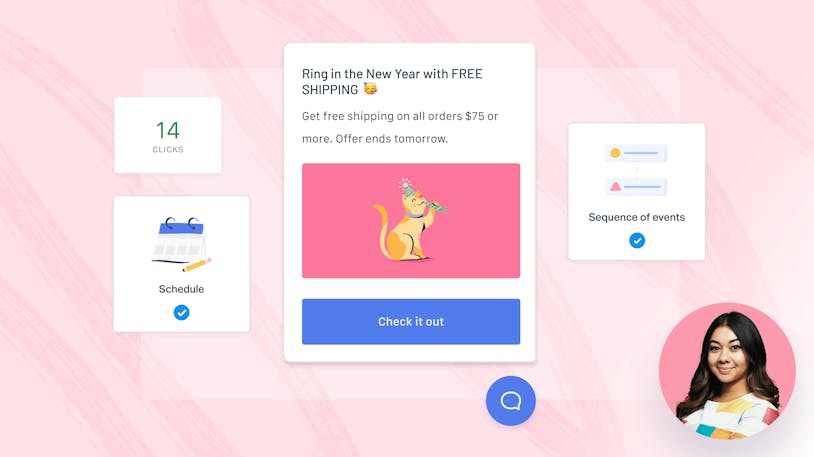How to Improve Ecommerce Customer Experience (11 Ways)


Ecommerce is a competitive field, and that means delivering an exceptional customer experience is more than just nice to have — it's a necessity. Understanding and prioritizing the customer experience can play an important role in setting your store apart and building long-term customer loyalty.
In this guide, we'll discuss 11 ways you can enhance your ecommerce customer experience, providing valuable insights that enable you to create a customer experience that truly sets your ecommerce business apart.
What is ecommerce customer experience?
Ecommerce customer experience is the overall perception a customer forms based on their interactions with an online store, including aspects like website navigation, customer service, and post-purchase follow-up.
Why is customer experience important in ecommerce?
Customer experience is important in the ecommerce industry for several reasons, including its impact on customer retention, revenue, and brand reputation.
Customer retention
With 95% of consumers saying that customer service is essential for brand loyalty, a positive customer experience is important for retaining customers. Satisfied customers tend to return for future purchases and are more likely to recommend your products to others. Retaining customers is also more cost-effective than acquiring new ones, as existing customers tend to have higher lifetime value and lower acquisition costs.
Revenue growth
According to Bain & Company, focusing on improving customer experience can directly contribute to 4% to 8% revenue growth, in part due to increased repeat purchases and reduced cart abandonment rates. In addition, better customer experience usually leads to higher average order values, as satisfied customers are more likely to spend more on their purchases.
Enhanced brand reputation
A strong customer experience can enhance your brand's reputation and make your ecommerce store stand out from the competition. Satisfied customers are likely to leave positive reviews and share their experiences with others through word-of-mouth marketing, which can significantly influence a shopper's decision-making process. A positive brand reputation helps build trust and credibility in the eyes of potential customers and can ultimately lead to increased sales and revenue.
Enhancing the customer experience and offering seamless interactions at every touchpoint of the online shopping journey can positively impact your brand and is an important investment.
How to improve customer experience in ecommerce — 11 ways
Wondering how your ecommerce business can improve customer experience? Fortunately, it doesn't need to be complex or overwhelming. There are several strategies that, when implemented well, can contribute significantly to a positive, seamless experience for your customers. Here are eleven ways you can enhance the customer experience in ecommerce, aiming to exceed your customers' expectations, foster loyalty, and cultivate a strong reputation for your online store.
1. Offer personalized ecommerce experiences
Personalization goes a long way toward delivering a seamless customer experience. By tailoring the shopping experience to meet individual needs, you echo the in-person shopping experience online which heightens a sense of value and recognition amongst your customer base.
Ecommerce personalization could mean anything from product recommendations based on previous purchases or displaying content relevant to the customer's geographic location to sending personalized emails based on user behavior.
Help Scout supports a personalized approach with customer profiles. This feature enables you to store data unique to your ecommerce business for each customer, giving your team a detailed understanding of your customers' needs. Through faster and more accurate responses to customer queries, your customers get more personalized and effective service, uplifting the overall ecommerce customer experience.
2. Implement a user-friendly website design
The key to a user-friendly site is to make it as simple as possible for customers to find what they need, learn about your offerings, and make purchases with ease. Responsive design is a great start, ensuring your site functions well across a variety of devices, especially considering the popularity of mobile shopping. A clean, intuitive website layout aids in easy navigation which, coupled with fast loading times, can significantly improve the user experience and retain site visitors.
Attention to your site's checkout process can prevent cart abandonment, a common issue in ecommerce. Simplifying the process by making it quick, straightforward, and transparent about costs can greatly enhance user engagement. It's beneficial to integrate trusted payment gateways with a variety of payment options to accommodate as many customers as possible.
An often-overlooked aspect of user-friendly design is accessibility, ensuring that your site serves customers of all abilities conveniently. Implementing various accessibility features ensures a versatile, inclusive platform that caters to all users, further enhancing the overall customer experience.
3. Add a live chat widget to your ecommerce site
Adding a live chat function to your ecommerce site can greatly enhance your customer's experience. With its real-time communication capability, live chat facilitates quick query resolution, immediate feedback, and a more interactive shopping experience. Its convenience effectively reduces the customer's effort, improving overall satisfaction and the likelihood that a customer shops with you again.
Integrating Help Scout's live chat feature into your ecommerce site can help fulfill these customer expectations. With Beacon, our web widget, you can provide real-time live chat support from any page on your site, allowing customers to obtain help without having to step away from their shopping experience.
4. Monitor and improve your ecommerce customer experience metrics
Key ecommerce customer experience metrics include customer satisfaction score (CSAT), net promoter score (NPS), customer effort score (CES), average resolution time, bounce rate, and cart abandonment rate, among others.
Tracking and interpreting these metrics can lead to actionable insights allowing you to enhance your customer experience strategy. For instance, a high cart abandonment rate may highlight issues with your checkout process, prompting you to simplify it for a smoother customer journey. On the other hand, a decrease in your CSAT score can be an indicator of dissatisfaction in your customer base, warranting deeper investigations.
Help Scout's satisfaction ratings feature proves quite useful in this scenario, allowing your customers to rate their support experience and providing you with direct feedback about their sentiment. You can also use a Beacon to send microsurveys to gather feedback fast. By monitoring customer sentiment, you can identify areas for improvement and continually maintain a high level of customer satisfaction.
5. Provide consistent and proactive communication
Ensuring clear, concise, timely, and consistent messaging aids in forming trust, reducing confusion, and setting clear expectations for customers. Consistency also helps to build your brand image and manage customer expectations, leading to a more satisfying ecommerce experience.
For example, proactive communication can help to preempt customer issues before they become full-blown problems. By reaching out to customers first, you can answer questions they may not have even realized they had, contributing to a seamless online shopping journey.
Here are some tips on how to achieve consistency and proactivity in your communication:
Maintain brand voice: Your brand’s tone and language should be consistent across all communication channels. Regardless of the customer touchpoint, ensure your message resonates with your brand values.
Automate responses: Use automated responses for common queries to ensure immediate, consistent replies.
Provide regular updates: Regularly update your customers with relevant information regarding their transactions. This includes shipping updates, stock issues, or simple "Thank you for your purchase" emails.
Anticipate customer needs: Use customer data to anticipate potential issues and communicate solutions proactively. This could be in the form of helpful blog posts, direct emails, or FAQ updates.
Help Scout offers a useful feature called Messages that allows for proactive, targeted messaging to customers. With this tool, you can approach customers with timely and appropriate content, helping them get the information they need without having to ask for it and enhancing your ecommerce customer experience.
6. Speed up response times
Providing quick solutions to customer queries or problems not only reinforces the value you place on your customers’ time but also builds trust and elevates satisfaction levels. This aspect directly ties in with an online store's reputation, loyalty, and customer retention rate, and it should be a top priority for ecommerce businesses aiming for a stellar customer experience.
Help Scout's saved replies feature enables your customer support team to create a database of saved responses for common customer queries or issues. These saved replies can be easily inserted into support emails, significantly decreasing response times.
7. Keep conversations organized
When customer conversations are stored in a well-structured way, it becomes easier to track issues, spot trends, and ensure timely responses, leading to improved customer satisfaction. An orderly system also aids in overall team productivity, minimizing confusion and ensuring that no customer slips through the cracks.
Help Scout supports this need for organization with its tags feature. Tags enable you to categorize and prioritize conversations based on their nature and urgency. They can be used to create reports and monitor trends in customer queries, helping you make data-driven decisions. Tags can also trigger workflows, automating certain aspects of customer service for greater efficiency.
Another valuable Help Scout feature to enhance conversation organization is the shared inbox. Unlike traditional email inboxes that are isolated and hard to manage, a shared inbox consolidates all customer communication at a single point, accessible by your entire team. This allows for greater transparency and collaboration.
8. Automate support tasks
Automating repetitive tasks frees up your team's time, allowing them to focus on complex tasks or providing more personalized and proactive customer support.
A powerful tool to aid the automation process is Help Scout's feature. As the volume in your inbox increases, workflows can boost your efficiency, helping you automate repetitive tasks and maintain low customer response times.
Workflows act based on conditions you set, performing a wide range of actions from the simplest routing tasks to more complex process automations. For instance, you can set up workflows to assign conversations to specific teams, move emails to custom folders, or tag conversations based on specific triggers.
This automation enables faster customer interactions, resulting in an improved experience for your customers and a more streamlined process for your team.
9. Integrate your systems
A well-integrated tech stack ensures that all your tools and platforms are communicating effectively with one another, enabling a smooth flow of data and providing your support team with the necessary information about your customers at their fingertips. With comprehensive customer data readily available, your team can better understand customer behavior, personalize interactions, and swiftly resolve issues.
Help Scout integrations add value to your customer support by allowing you to connect Help Scout to over 100 other web services your business relies on. From CRM tools like Salesforce and HubSpot to ecommerce platforms like Shopify and WooCommerce to marketing services like Mailchimp and ActiveCampaign, Help Scout's integrations enable you to leverage the tools and platforms you already use to optimize your customer experience.
10. Improve the delivery process
A key factor in creating a positive ecommerce customer experience is consistently providing an efficient and transparent delivery process. By monitoring your delivery procedures and proactively making improvements, you can effectively minimize delays and enhance overall customer satisfaction.
One way to improve transparency is by offering customers a variety of delivery options and keeping them informed about costs and delivery times. Further, providing tracking capabilities empowers your customers to keep a close eye on their orders throughout the process, giving them peace of mind and a sense of control.
It's also essential to collaborate with reliable shipping partners, considering their performance directly impacts customers' experiences with your business. Carefully selecting the right partners, maintaining open communication, and setting clear expectations can contribute to the smooth execution of deliveries and secure a satisfying ecommerce experience for your customers.
11. Provide self-service options
A majority of customers appreciate the convenience and speed of finding answers to their questions independently, without having to wait for a support agent. By offering self-service options, customer support teams can significantly reduce incoming support requests while still ensuring that customers get the necessary information.
Docs, Help Scout's knowledge base solution, is an effective tool to address the demand for self-service options. You can create a comprehensive repository of information where customers can find answers to frequently asked questions or troubleshoot issues on their own. Docs articles are accessible via a customizable help center or they can be surfaced anywhere on your site using a Beacon. This reduces the need for support requests and leaves customers more satisfied with their experiences.
In addition to customer satisfaction, the knowledge base can also provide valuable insights into customer behavior. By using the Docs report feature, you can monitor what your customers are searching for and whether they're finding what they need. This information can help you identify knowledge gaps and optimize your self-service content.
Ecommerce customer experience trends
As the ecommerce landscape continues to evolve, new trends are shaping how companies deliver and optimize the customer experience. Here are some of the current trends to keep an eye on.
Personalization
With 73% of consumers expecting brands to understand their individual needs, personalization is less a trend than it is an ongoing necessity. Consumers expect a tailored buying experience that caters to their individual desires and preferences. Ecommerce businesses are leveraging customer data like browsing history, previous purchases, or demographic information to create personalized recommendations, marketing messages, and support interactions that resonate with each user.
Omnichannel support
In the age of digital interconnectedness, customers interact with brands across various channels, from social media to mobile apps, email, and web support. Providing a consistent and seamless customer experience across all these touchpoints makes a big difference. An omnichannel approach ensures that customers receive the same quality of service, regardless of the channel they choose.
Artificial intelligence and chatbots
The growing use of artificial intelligence (AI) and chatbots in customer support provides businesses with an opportunity to engage with their customers in a quicker and more efficient manner. While AI-powered chatbots can handle repetitive tasks and simple queries, they also free up human support agents to address more complex issues, saving businesses up to 2.5 billion hours of work and leading to a balanced and effective support ecosystem.
Self-service support
As mentioned earlier, self-service support options like knowledge bases, FAQs, and wikis have become more popular and sought-after among customers, with 91% of consumers indicating that they would use a knowledge base if it was available. Businesses that make information easily accessible and up to date enable their customers to find solutions independently, leading to increased customer satisfaction and reduced support load.
Customer feedback
According to the research, companies that start with collecting and analyzing customer feedback are able to implement more successful customer experience projects, which means understanding customer needs and gathering feedback has become increasingly beneficial for businesses wanting to fine-tune their customer experience strategies. Ecommerce businesses are adopting more proactive approaches, including post-purchase surveys and social listening techniques, to collect and analyze customer feedback, address pain points, and continually improve their service.
Boost ecommerce success with exceptional customer experience
In the evolving digital marketplace, customer experience serves as a differentiating factor for ecommerce businesses vying for customers' attention.
Help Scout can play a vital role in this process. Offering an array of tools to streamline communication and improve customer support, Help Scout enables you to work toward enhancing your ecommerce customer service experience. With options for automated responses to common queries, monitoring tools for performance measurement, and a robust knowledge base for proactive customer support, Help Scout has the tools you need to build a customer-oriented ecommerce business.
Sign up for a free trial of Help Scout and discover how our platform can support your business in delivering exceptional customer experiences.
The Supportive Weekly: A newsletter for people who want to deliver exceptional customer service.












